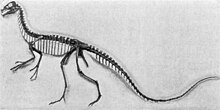Ornitholestes
Ornitholestes (meaning "bird robber") is a small theropod dinosaur of the late Jurassic (Brushy Basin Member of the Morrison Formation, middle Kimmeridgian age, about 154 million years ago[1]) of Western Laurasia (the area that was to become North America).
To date, Ornitholestes is known only from a single partial skeleton with a badly crushed skull found at the Bone Cabin Quarry near Medicine Bow, Wyoming, in 1900.
[2] The holotype skeleton (AMNH 619) was excavated in July 1900 in the Bone Cabin Quarry in Wyoming by an American Museum of Natural History expedition by Peter C. Kaisen, Paul Miller and Frederic Brewster Loomis.
[6][7] The species name (O. hermanni) honors Adam Hermann, the head preparator at the Museum, who directed the restoration and mounting of the skeleton.
"[9] In 2005, Kenneth Carpenter et al. described a new small theropod, Tanycolagreus, whose skeleton was found in Bone Cabin Quarry only a few hundred yards from AMNH 587.
[10] Since AMNH 587 was virtually identical to the preserved hand of the Tanycolagreus type specimen, it is now considered to belong to that dinosaur and not to Ornitholestes.
[3] However, this reconstruction was inaccurate, being based in part on Othniel Charles Marsh's restoration of the basal sauropodomorph Anchisaurus, and the neck and trunk were both too elongated.
[22] Its head was proportionally smaller than that of most other predatory dinosaurs, but the skull was heavily built, with a short snout and robust lower jaw.
[32] An area of broken bone near the external naris (nostril) appears to bulge upward, which led Gregory S. Paul to suggest in Predatory Dinosaurs of the World (1988) that Ornitholestes had a nasal horn "rather like a chicken's comb in looks.
Rauhut (2003) and Kenneth Carpenter et al. (2005a) rejected that interpretation, and indicated that the upward flare of bone was due to post-mortem crushing of the skull.
[53] In 1988, Gregory S. Paul suggested that Ornitholestes was very similar in skull structure to Proceratosaurus, a Middle Jurassic theropod from England.
[57] †Bicentenaria †Zuolong †Tyrannosauroidea †Aorun †Scipionyx †Ornitholestes †Compsognathidae †Ornithomimosauria Maniraptora In an abstract presented at the 2021 conference of the Society of Vertebrate Paleontology, Kimberley Chapelle and colleagues found "robust evidence" that Ornitholestes is the earliest-diverging oviraptorosaur, based on a CT scan analysis of the skull.
[58] In a 2001 study conducted by Bruce Rothschild and other paleontologists, 20 foot bones referred to Ornitholestes were examined for signs of stress fracture, but none were found.
[59] A biomechanical study conducted by Phil Senter (2006) used articulated casts of the Ornitholestes type specimen's right forelimb to determine its range of motion.
[61] The ability of Ornitholestes to bend the forearm to an angle significantly more acute than 90° is characteristic of Maniraptoriformes, but absent in more primitive theropods such as Coelophysis and Allosaurus.
[33] Norman (1985) suggested that the robust skull and jaws might have allowed Ornitholestes to tackle "larger and more active prey" than other small theropods.
"[69] In 2007, John Foster, a specialist on the Morrison Formation, suggested the possibility of niche partitioning between Ornitholestes and its contemporary Coelurus, which was within the same size range.
[70] Foster noted, however, that this hypothesis was largely speculative; a lack of preserved skull material from Coelurus makes it impossible to verify whether its eyes were proportionally smaller than those of Ornitholestes.
[73] However, this interpretation was largely disregarded for over half a century; most reconstructions of theropod dinosaurs, including Ornitholestes, portrayed them with reptile-like scaly skin.






